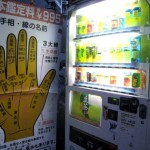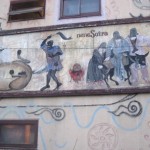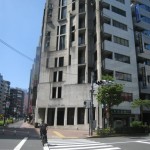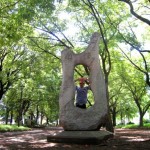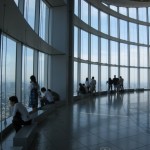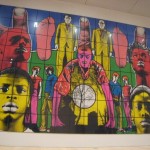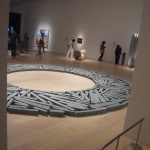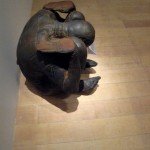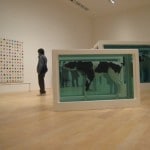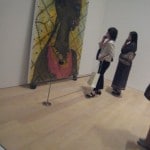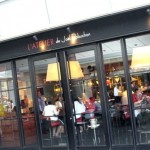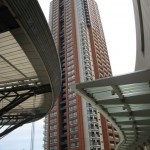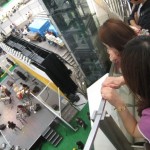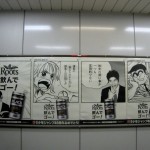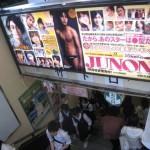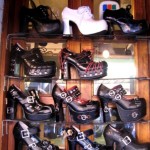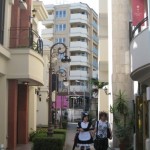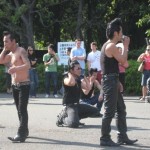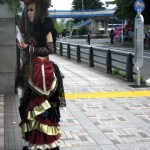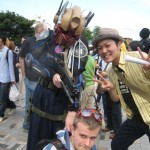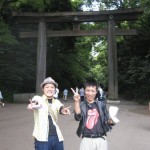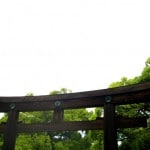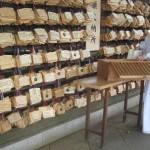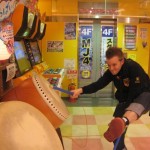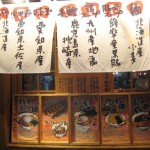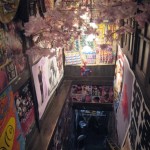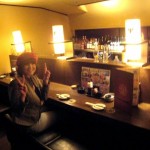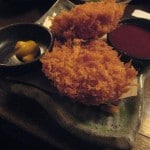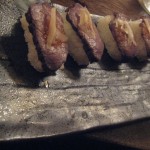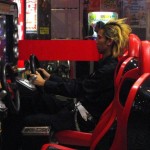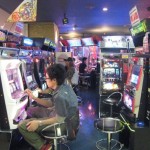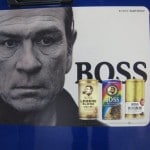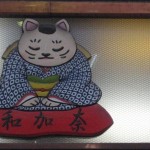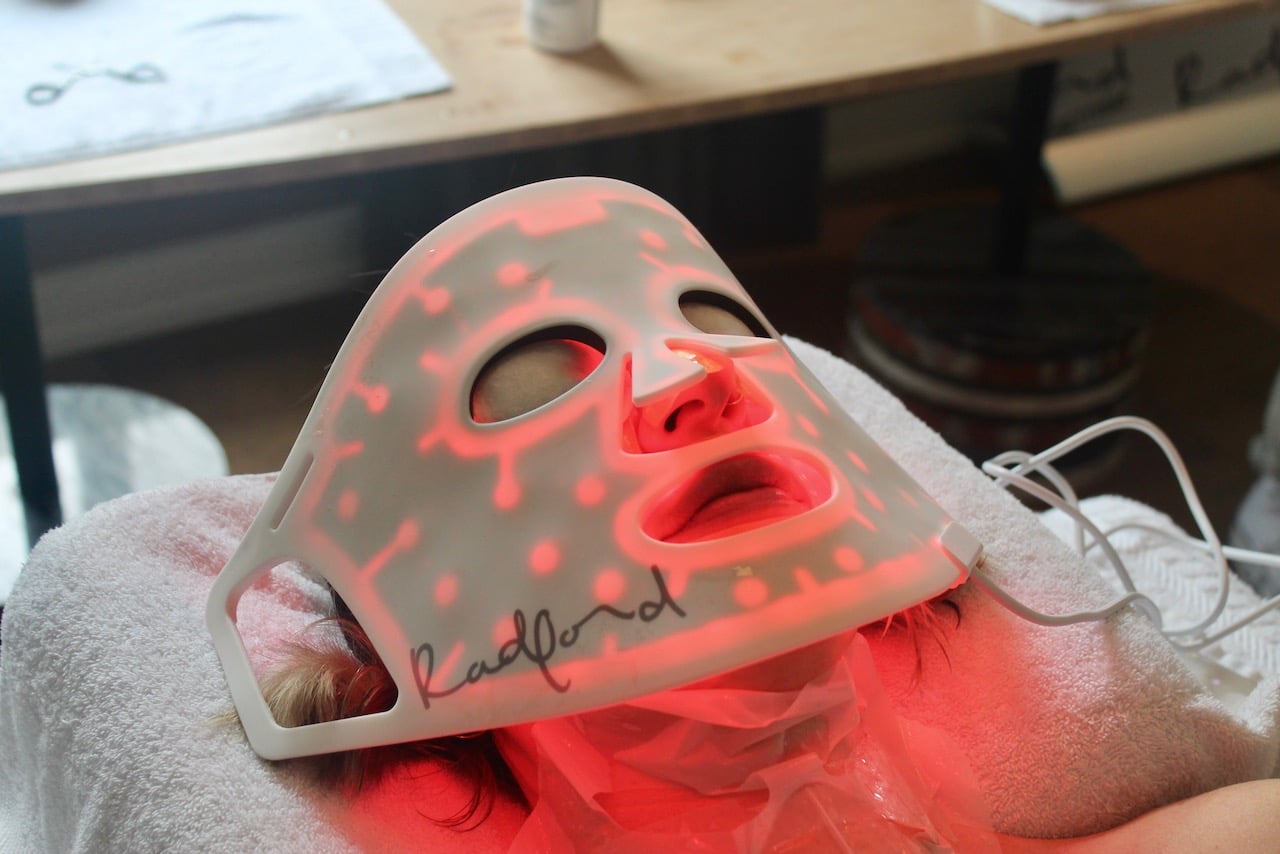I hopped off the train at Shibuya Station and lugged my things to the main JR Rail lobby. I leaned against a massive stone pillar and sighed. It seemed like hundreds of people were whizzing by as I stared up at a huge, massive, gigantic Tokyo Subway Map. At first glance it looked like a multicoloured contemporary art piece. I walked over to the ticket machine and spent the next ten minutes hopelessly trying to figure out how to purchase a ticket to Ikebukuro Station.
I walked up the platform steps as my massive back pack attempted to drag me down the stairs. I clutched the banister and made it to the top with closed eyes and a sigh. I soon groaned, noticing hundreds of people waiting in line for the next train. It was 9pm on a Saturday evening, rush hour, dangerous here in Tokyo. I forced myself to stay alert by pinching the insides of my cheeks. Then the train slowed to a stop and the indoor chimes let of an overly jubilant sonata and everyone pushed into the crammed train car. I stood squished in the middle of the train surrounded by what appeared to be the entire city of Tokyo. I could not move as my bag was jammed in between two people behind me. I could not turn to apologize. I could not apologize for that matter, I do not speak Japanese. I occupied myself by staring at the train plasma screens which announce delay times on each of the various Japan Rail Metro lines and chimes each upcoming stop.
At Ikebukuro I darted out the door by lunging forward. I used the weight of my body and the hundred pounds of stuff strapped to my back to propel me towards the exit. I ran through the massive station to the West exit. I had just made it through the worlds second busiest train station in the world (Tokyo Metro Railway cites that the average commuter traffic through this station is one million people a day, second only to Tokyo’s Shinjuku station). Standing outside I stared up at a massive traffic loop and skyscrapers glowing in the black of night. With hostel map in hand I found my way down the main street and moments later lost on several very tiny side streets. Scooters zoomed past me as I searched for some sort of landmark (even though my map was barren of such novelties). I stopped by a fish monger who was closing up shop. As he threw fish guts into his garbage bin he motioned for me to head down the street. I bumped into a hunched back 80 year old grandfather five minutes later who took me to the hostel entrance.
The hostel is located in the basement of an apartment building. It would have helped if they had explained this on their website but what can you do. I headed down the steps and was greeted by a tall white woman with long curly bleached hair and dark brown roots. Her face was covered in white cream (as if she had been sun bathing and had applied to much sun screen to her face) and stood holding a French Knife with her left hand. In a thick German accent she started to interrogate me. Asking why I had a German flag on my jacket (why on earth would anyone wear a German flag if they were not from Germany? She could not grasp this concept). I was soon interrupted by this German nut job by the owner of the hostel. His name I won’t even begin to attempt to pronounce. He wore white brief underwear and a yellow undershirt stained with what looked like tomato sauce. His entire body was covered in hair. He motioned me to my bed and with a crooked smile shook my hand and told me he was from Istanbul. I spent the rest of the night introducing myself to the other guests at the hostel (an Australian girl who had been living in the UK for the past year, two rather vulgar boys from Brighton, a crazed German French Knife wielding psycho and a hair covered Turk).
I sat beside Kat, the Australian, who would become my new best friend. The crazy German rambled on about nothing for several minutes, picking at her French Knife and scaring the entire room with her manic behavior. As soon as I met her I assumed she was a drug user. The hostel consisted of two rooms divided by the sexes. I bid Kat adieu and spent the next two hours trying to fall asleep on my bed. This bed wasn’t so much a bed as it was an incredibly thin matt placed atop a wooden board.
The next morning Crazy German was told that her prolonged stay at this particular hostel would be cut short. She was told to leave. Kat told me that Crazy German had screamed all night about keeping the door open for fresh air (even though we were in Tokyo and fresh air really doesn’t exist). Another sign that our German was delusional. She apparently sat up in the middle of the night screaming, “shiza shiza.”
I left in the early morning for the subway and found myself standing under Tokyo Tower at 9am. The tower is situated within a park area full of mature tree’s and a stream. Directly across from the Tower entrance is Zojoji Temple which can be found down a little side street towering with bamboo trees.
Zojoji was my first visit to a Japanese Buddhist Temple and I noticed a few major differences from Korea’s places of worship. At the entrance of the temple stood a large brass bowl full of sand. Incense sticks slowly burned and locals waved their hands over the clouds of incense and washed their bodies with their strong aromas. A cleansing of the body before entering the sacred temple. To the right of the temple was a decorative gate covered in wood plaques. Visitors are asked to write a wish on a slab of wood and these are all hung on the walls of the gate. Each day the Buddhist monks pray for all of these personal prayers. I read a few written in English, “world peace, a prayer for the sick and an end to intolerance.”
As I walked through the gate towards a seated stone Buddha I was fascinated by hundreds of tiny statues. These stone statues are called Jinzo (or Ksitigarbha in Mayahan Buddhist Bodhisattva tradition) and wear red bibs and hold colourful pinwheels which spin in the wind. The Jinzo in Japan is one of the most loved of all divinities. He is traditionally seen as the guardian of children, particularly children who died before their parents. He is seen as the savior of souls who have to suffer in the underworld and his statues are common in cemeteries. He is also believed to be the protective deity of travelers, and roadside statues of Jizo are a common sight in Japan. The hundreds of Zojoji Temple each represent a dedication to a lost baby’s life. Families dress these statues up, provide gifts and use them as a memorial towards their lost child.
These statues of remembrance line the entire perimeter of the temple complex. I walked through the backyard where several life size Buddha brass statues stood quietly in the garden. The temple architecture is beautiful curved roof with dark brown and black colour schemes. Very different from Koreas multi-coloured palaces and shrines. Inside I sat down on the floor and watched what appeared to be a wedding ritual.
Next stop Roppongi Hills. I stood at the neighborhoods most famous intersection and meeting point, The Almond confectionary shop. The store is painted bright pink and located directly outside of the subway station. I walked along the busy Sunday shopping streets towards the Roppongi Hills complex. Roppo Hills is one of Japan’s largest integrated property developments. Constructed by building tycoon Minoru Mori, the mega complex incorporates office space, apartments, shops, restaurants, cafes, movie theaters, a museum, a hotel, a major TV studio, an outdoor amphitheater, and a few parks. The centerpiece is the 54 story Mori Tower. Mori’s stated vision was to build an integrated development where high rise inner urban communities allow people to live, work, play and shop in proximity to eliminate commuting time. He argued that this would increase leisure time, quality of life, and benefit Japan’s national competitiveness. Its construction cost over $4 billion. The 27 acre site amalgamated more than 400 smaller lots Mori acquired over 14 years.
I instantly fell in love with Roppongi Hills. It is incredibly hard to describe my feelings on the subject. Nothing like it exists in the world. Everything about the space screamed creative, wealthy Japan. I walked up the main steps to find a circular garden with a perimeter featuring a plume of frothy cascading waterfalls. The entrance of Mori Tower features a massive spider sculpture by famed French artist Louise Bourgeois. I stared up under the belly of this arachnid and the sun blinded me as I stared up at the top of the surrounding skyscrapers.
I walked through shopping arcades which featured expensive cafes and book stores. I leaned on a granite pillar and stared into a salon as two incredibly wealthy Japanese woman had their nails and hair done simultaneously, while talking on their cell phones. I found an expansive balcony which overlooks the amphitheater, a lily pond and Tokyo Tower in the distance. I walked up a spiral stair case and stared down bellow in shock to see that I could see down four floors of Roppongi Shopping Center to an immaculate rock garden as the afternoon sun threw dramatic shadows across its surface. The spiral stairs were encased by a criss-cross glass wall which made me feel as though I was walking up a champagne flute. At the top of the stairs I walked into a luxury elevator (red carpet and gold buttons?) and arrived at the entrance to the Mori Art Gallery.
I walked down a long hall which featured a glass dome overhead. The Mori Art Gallery lobby was entirely made of black granite and there were approximately three employees for every guest. I was motioned to a spare ticket agent by a man wearing a tuxedo and white gloves. I purchased my ticket and walked down a long hall where I counted ten tuxedos and twenty white gloves as they bowed and motioned to the end of the corridor. Two stiletto wearing models pranced across the end of the corridor in black evening gowns to motion the waiting group towards a free elevator. These two ladies were responsible for elevator traffic. Once we were in the elevator the door slowly closed and both ladies bowed to the floor as the lights in our elevator dimmed. The elevator in Mori Tower is the second fastest elevator in the world (after the elevators in Taipai 101). We were surrounded in black but soon the roof of the elevator started to glow green, blue and pink as our ears popped. I could feel our elevator blasting into space and watched the floor numbers spin by. We went from three stories to fifty-three stories in less than fifty seconds! I was in an elevator full of older woman who were giggling from the whole experience.
The doors chimed, opened and we were blinded by daylight. I handed over my ticket and turned a corner. I immediately stood in awe at the spacious glass Mori City View. The atrium is over 11 meters high and a 360 degree window offers a panoramic view of the city from the sky. From 250 meters above sea-level, you can appreciate the metropolis of Tokyo as a work of art. I walked towards the window and sat myself down on a little leather bench looking directly over the city. You literally feel as though you may fall into the sky as you appear to be hovering over the city. On a clear day you can see Mt. Fuji in the distance. The cities remarkable highways, skyscrapers and impressing large green spaces are a treat this high. I walked along the 360 perimeter view quietly contemplating how on earth I could manage to befriend this Mori character. He is considered Japan’s most powerful and influential building tycoon. He and his brother have been listed on the Forbes list of the world’s richest men and in 2007 he was awarded Asian Businessman of the year by The Fortune magazine. This guy seemed like a promising pen pal.
The Mori Art Center is one of Tokyo’s top three Contemporary Art spaces. I was fortunate enough to be at the gallery during the “History in the Making: A Retrospective of the Turner Prize,” exhibit. The exhibits tag line runs across the entrance, “the world’s most innovative art, discovered by its most prestigious prize.” The Turner Prize, named after the painter J.M.W. Turner is an annual prize presented to a British visual artist. It is organized by the Tate gallery in London and since its beginnings in 1984 it has become the UK’s most publicized art award. This exhibit examines a period that covers New British Sculpture of the 1980’s, and the latest trends from 2000 onwards. The exhibit focuses principally on works made by each recipient at around the time when he or she won the Prize, allowing viewers to experience first hand the very same wit, humor, concepts, pop-culture, and sheer emotional impact that originally impressed the Prize’s jurors.
I spent the next hour staring at works by sculptor Tony Crag, photographers Gilbert and George, prominent shocker Damien Hirst who sliced a cow and calf in half and preserved them in formalin, African painter Chris Ofili, portrait artist Wolfgang Tillmans and modern vase creator Grayson Perry.
I walked down a long hallway and past a gorgeous café which offered a stupendous view over the city (but sadly sold croissants for ten dollars and espresso’s for fifteen). I was surprised to realize that there was another art exhibit, Transparent Speed: BMW Art Car Collection which was included in my Mori Art Gallery ticket. A great treat indeed! I walked into the black entrance which was entirely void of light. I could hear the sound of ocean waves and in the distance what looked like a lighthouse beam circling the next room. The spirited architect, Jun Aoki, has produced a spatial composition for this exhibition in an attempt to give visual form to the “transparent speed” of automobiles. In the exhibition space that Aoki has created, art cars by remarkable artists such as David Hockney and Roy Lichtenstein are on display. This show is a part of the worldwide exhibition “Auto-Nom-Mobile,” held in 2005 to celebrate the 30th anniversary of the BMW Art Car Collection. After Japan, the exhibition will tour the United States, Canada and Europe. The speed of the art cars was visually rendered by approximately 10,000 transparent cloud-like pipes through which lights will move around and reflect off of in a diffuse manner. There are two main elements that motivated this idea of being “within the clouds”: the BMW brand being originally a design and manufacturing company of aircraft engines; and the location of the site on the 52nd floor of the building.
The room was entirely silent other than the sound of ocean waves. The crystal glass tubes which hung from the ceiling created a cloud like atmosphere in the gallery space. Each room featured an incredibly powerful BMW muscle car which had been painted by a famous contemporary artist. One of the Formula 500 cars had quotes painted all over the hood which I scribbled down in my book. I was startled when a one of the gallery staff tapped on my shoulder and told me I was not allowed to write with a pen and handed me a small pencil the size of a tooth pick. The car quoted, “you are so complex you don’t respond to danger,” “lack of charisma can be fatal,” and “monomania is a prerequisite to success.”
I left the gallery and hopped back in the elevator which now dropped to ground level at lightening speed. I was thrilled to discover that Japan’s National Beer Festival was taking place in Roppongi Hills on this very day! The amphitheater was full of thousands of people quaffing beer steins and listening and watching live Japanese pop and rock musicians on stage. The atmosphere was fantastic for a tourist who had no clue such a celebration was to take place. The thrill of happenstance! I ordered a stein of Asahi and Sapporo and spent the next forty-five minutes standing beside a banister looking down at a rather excited Japanese pop singer as he threw his guitar around the stage. Directly across from where I stood, the upper crust sat eating at L’Atelier de Joel Robuchon. I wondered if Mr. Mori was in there, and perhaps, would he mind inviting me for lunch?
I was sloshed by 1pm. The air smelled of hot dogs, greasy French fries, caramelized onions and sweet miso mayonnaise. I plugged myself into my iPod and danced down the street to David Guetta’s Pop Life album. A slight beer induced tips at midday surprisingly makes the world seem so much clearer. I skipped down the street past several small million dollar villas with Rols Royce’s sitting on parking lot elevators. I ran into a dimly lit highway tunnel and laughed as a biker gang of pimped out Honda cycles zoomed across the highway. In the middle of the tunnel I stood with my mouth hanging open as I stared up at a massive tree shooting through a giant oval which had been incorporated between the lanes above. Only in Roppongi Hills will you find trees growing through highways, fantastic sky high art pieces and the most fantastic Japanese pop-culture ambiance.
I zoomed across the city on the subway to Harajuku Station. The area is known internationally for its youth style and fashion. Directly across from the station is Takeshita-dori (street). Standing at the entrance of Takeshita on a Sunday afternoon is overwhelming. You have to push through thousands of youth as millions of locals fill the street to do their shopping. I looked down the road and all I could see was a massive ocean of bobbing heads.
Harajuku became a recognizable name after Gwen Stefani released her debut album Love Angel Music Baby. Several of her songs refer to the street fashions of Japan and Harajuku girls in particular. These girls are members of various sub cultures including Gothic Lolita, Gyaru and Kogal. They may also be dressed as characters from anime, films or manga (known as cosplay).
A short description of the various Harajuku subcultures for your convenience:
Gyaru: a Japanese translation of the English word “gal.” The name originated from a 1970’s brand of jeans called “gals,” with the advertising slogan: “I can’t live without men,” and was applied to fashion and peer conscious girls in their teens. The term gradually drifted to apply to a younger group, whose seeming lack of interest in work or marriage gained the word a childish image.
Banba: Barbie gal, with differences such as their wearing of slippers and stilettos. They also use more glitter, and have a neon touch to their hair. They use more extreme looking types of false eyelashes and coloured contact lenses.
Kogal: subculture of girls and young women in urban Japan, who are characterized by conspicuously displaying their disposable income through distinctive tastes in fashion, music, and social activity. In general the kogal look roughly approximates a sun tanned California Valley Girl, and indeed, there are even some linguistic similarities between these Western groups and Kogal. Both subcultures have derived entire sets of slang terms. Kogals are known for wearing platform boots, miniskirt, copious amounts of makeup, hair colouring, artificial suntans, and designer accessories. Kogal’s busy social lives and desire for new goods lead them to be the first consumers of Japanese cell phones, and their taste in cloths tends toward Burberry scarves and Louis Vuitton handbags.
Gothic Lolita: this aesthetic has been described as a reaction to the kogal look, since it attempts to reclaim childhood innocence. The fashion draws of its inspiration from Rococo, Victorian style and Edwardian fashion and often aims to imitate the look of Victorian children or porcelain dolls. Girls carry delicately embroidered umbrellas and wear Victorian blouses, crinoline or petticoat and poofy black skirts.
Cosplay: short for costume play is a subculture centered on dressing as a character from manga, anime, tokusatsu, or video games.
In Japan, it appears that the more you stand out the better!
Tourists and locals alike head to Harajuku Station every Sunday to shop and more importantly be entertained by the various fantastical fashion subcultures. All of the action can be found on the bridge which connects Harajuku with Yoyogi Park.
Standing on Takeshita-dori I was entirely lost and decided to walk down a side street in hopes of finding the Yoyogi entrance. At the very end of a dead end street I found two twenty three year old University students slurping down cups of bubble tea. I asked them directions and they both bolted up and instantly declared themselves my personal tour guides and best friends.
For the next several hours Taka and Ken, two guys from Fukoka, self consciously asked me various questions about where I come from as well as English words and concepts they didn’t really understand. We instantly hit it off. We walked along a spa filled street dotted with lush green trees. Each building had large glass windows so we could peak in and see all of the rich youth spending the weekend getting a proper pampering.
On the short walk from Harajuku Station to the Yoyogi Park Bridge we ran into several interesting people. My head turned when I noticed a group of six men who looked to be in their late 40’s dressed in school girl costumes. A double take, I spinned around and looked at them again to make sure they were indeed full grown men dressed as Japanese middle school girls. Taka and Ken laughed at my reaction and explained in broken English, “they not gay, they love school girl style, they married, it is their hobby.” I could not help but laugh. In North America I can not imagine a group of middle aged men getting together and dressing up as school girls to walk around in public. Apparently their wives encourage this hobby. The whole dressing up as a little girl thing doesn’t seem to freak their wives out. Perhaps the world would be a better place if full grown heterosexual men could enjoy the time old tradition of getting together with their mates and dressing up as their daughters. I try to imagine what it must feel like to run into your father on the weekend as he is dressed up as, well, you.
I was gitty with excitement when we arrived at the bridge. On the right side of the bridge stood around thirty cosplayers dressed as famous anime and manga characters. Several of them put on mock samurai sword battles. I ran into a bizarre character wearing a Transformers mask, holding a plastic semi-automatic weapon and dressed from neck to toe in manga attire. I gave him the thumbs up and said, “very cool.” And I was shocked that I received a “thank you,” in a thick Texan accent. Back home, Caucasian people obsessed with manga and anime typically fall into a nerdy category. I remember passing by the Anime and Manga Club at the University Club Fair every year in Guelph and cringed at the sorts of people who lived in these fantasy worlds. This misfit from Texas clearly fits in here (which I think is great) and ran around the bridge all day having his photo snapped with tourists. He insisted that Taka take a picture of me on my knees as he shot me in the head. I didn’t feel safe refusing such a request and the picture will always be cherished I assure you. On the other side of the bridge stood many Lolita girls dressed in pink, black, red and white, chitchatting and snapping pictures with tourists.
At the end of the bridge we met a fork in the road. We took the left and arrived at Yoyogi Park where a huge crowd of people formed a circle around ten Rockabilly dancers. These middle aged Japanese men dressed in jeans, leather boots and black undershirts dance to rock and roll tunes of the 1950’s. They all had massive greased rooster hair standing on their heads like crack infused Elvis impersonators. I was told that these guys have been doing this for years every weekend in the Park. Somewhat of an interesting tradition. It is really interesting to see how American pop culture from the past has influenced far away cultures such as Japan. I am certain Elvis would have been shocked if he were told that a group of Japanese impersonators would be dancing to his music in the middle of Tokyo.
The Park offers a large green space for locals to hang out. And do they ever. The place was full of studying students, poets, writers, chit chatters and Frisbee throwers. On Sunday’s local rock bands perform under the shade of moss covered trees. We sat under our very own tree and chatted about life while I simultaneously stared at a man dressed in a cow costume singing on a microphone as his friend dressed as a princess played the banjo.
We walked back over the bridge and met a British radical Christian who stopped us on the street and fed us some of his wild ideas. He spoke so quickly I found it difficult to understand a word he was saying. He pointed to his Japanese wife who apparently was a survivor of the tragic Hiroshima bombings. They have dedicated their lives to improving the world by spreading peace, pamphlets and manic banter. He insisted that the name Lucy stems from the word Lucifer and that he is not actually a member of the United Kingdom. “No, defiantly not! The country is at war! I am from the DK (Departed Kingdom).” We waved our crazy friend goodbye and looked through his rather colourful pamphlet. The front of the handout features a human head and the numbers 666. The literature starts by reciting Revelation 13:16. It continues and becomes a rather enjoyable read:
“The apostle John, predicts that a global economic system will one day be instituted in which everyone will be forced to receive a number, without which they will not be able to buy or sell. It is only since the advent of computers and electronic banking that this prophecy could be fulfilled. We are well on the way to eliminating cash. Advocates of a cashless society have many compelling reasons why. A primary one is that cash is the mother’s milk of drug smugglers, who often deal in cash a suitcase-full at a time. With no cash, the sale of illegal drugs would be greatly hampered. In fact, law enforcement agencies say that to eliminate cash would eliminate most kinds of criminal activity. Before cash, checks and credit cards can be phased out completely, an absolutely foolproof identification system must be developed and implemented. A cheap and workable solution would be to take a chip similar to those used in smart cards and place it under your skin. You would then become your own smart card and the very difficult and expensive problem of making sure the owner of the card who he is says he is, is solved! A global cashless society is in the marking! For the first time, the means of fulfilling the chilling vision of the Apostle John received nearly two thousand years ago is here!
Remember the coming world leader will demand the world’s worship! This is what Satan is really after when he causes his puppet, the Antichrist, to set up the one world credit system: to force the people of the world to bow down and worship him!
<and it continues to get better>
Watch out for 666! So there will be more to accepting “the mark of the Beast” than merely an economic decision. Though disguised as a technological breakthrough for the betterment of society, voluntarily receiving it will primarily be a spiritual decision to accept and worship the demonic Antichrist. This is why the Bible warns, “if any man worships the beast and his image, and receives his mark in his forehead, or in his hand, the same shall drink of the wine of the wrath of God.” God would not meet out such stiff punishment for simply accepting an identification and credit mark that allows you to buy your groceries!
Holy Cow! I never thought I’d read the words: God, Antichrist, computer chip and groceries in the same paragraph.
We walked back to the fork in the road and continued up the other path towards the cities famous Meji Jingu (shrine). This shito shrine is dedicated to the deified spirits of Emperor Meiji and his wife. The construction of the shrine began in 1915 and was built in the traditional Nagarezukuri style and is made up primarily of Japanese cypress and copper. The shrine is located in 175 acres of forest, of which stand 120, 000 trees of 365 different species which were donated by people from all parts of Japan when the shrine was established. This tranquil forest is visited by many people both as a spiritual home and place for rest and relaxation.
At the entrance stands a massive torii, a formal wooden gateway indicating that you are entering a sacred place. We crossed over a small bridge and walked up several gravel paths before arriving at a road flanked on both sides by colourful sake barrels. Arriving at the Shrine we stood by a masterful work of nature, a lush green ancient oak tree. Thousands of prayer plaques hung on boards which surround the tree. One prayer caught my eye and made me laugh, “Go Habs Go!” Oh Canada, sometimes I miss you. I was enjoying myself in a euphoric culture shock sort of way so grabbed a plaque and wrote, “The world is perfect at this very moment.”
We walked back to the hectic Takeshita-dori street because Ken insisted that I enjoy a famous Harajuku treat. I had noticed all of the locals munching on crepes throughout the day and I agreed I needed to try them for myself. The boys took me to the most famous crepe shop and I stood in front of a huge menu desperately trying to make my decision. I settled on the Harajuku classic: a crepe filled with slices of vanilla cheesecake, chocolate sauce, fresh strawberries and whipped cream. We walked back to the station and I hugged Taka and Ken and waved goodbye as I collapsed into my train car.
I arrived back in my little nook of Ikebukuro and grabbed a relaxing shower and spent another thirty minutes flipping through many beautiful Japanese anime comic books. I spotted my Australia friend Kat and we excitedly decided to head out for dinner together. Ikebukuro is the entertainment and amusement hub of the city. The streets are lined with Karaoke Bars, The Sega Amusement Center, Casino’s and many mechanical claw prize grabbing game rooms.
After several minutes of restaurant debate we found a lovely establishment underground. Arriving at the host desk we took off our shoes and walked into a locker room where we placed our sneakers and locked them for the duration of our dinner. I was incredibly excited as we walked through an upscale traditional Japanese restaurant. Diners sat on the floor, or on leather cushioned seats while their feet dangle under dug out spaces in the floor. Each private dining area in the restaurant was divided by paper wall sectionals. We were seated directly in front of the bartender at a mahogany table. We sat on our cushioned leather seats while our feet dangled underneath the table top. The ambiance was entirely calming, jazz music, dimly lit lighting and the beautiful rumble of Japanese table banter.
We stared at our massive menu and I spot a few interesting offerings. Such as “deep fried chicken cartilage and an expensive plate of horse sashimi.” I really wanted to try the horse sashimi but I didn’t’ want to order an entire plate of horse as I may not have enjoyed it. No one wants to waste an entire plate of raw horse flesh, that would just be rude! I had a delicious meal of traditional Japanese beef croquttes, Gyoza dumplings, roast beef and wasabi sushi and a bowl of fresh edamame.
After dinner we skipped through the glowing streets buzzing with entertainment excitement. We walked past a Takifugu restaurant (the pufferfish which can notoriously kill you if it is not prepared correctly). The fish is highly toxic, but despite this, or perhaps because of it, it is considered a delicacy in Japan. Only specially licensed chefs can prepare and sell fugu to the public. The fish contains lethal amounts of the poison tetrodotoxin in the skin, liver and ovaries. Since small amounts of the poison give a special desired sensation on the tongue, certain parts are considered the most delicious by some gourmets. We pocked our fingers at the restaurants massive display tank. They didn’t look that harmless to me. Just don’t let their skin or ovaries touch you!
Kat lunged at a bubble tea booth. We ordered a melon flavoured green tea infused tapioca beverage and slurped it on the way home. As my eyes started to force themselves shut we ran into a liquor store before it closed. Seeing that everyone is terrified of the “outrageous” prices in Japan I was looking forward to seeing how expensive some of these wine and spirits sold for in the heart of Tokyo. I was floored, elated and jealous…and in that order. I almost fell over when I saw a large bottle of Smirnoff Vodka for $13, and a bottle of Robert Mendovi Chardonnay for $8. Life isn’t fair.
And with that, I headed to bed. I.E. my paper thin mattress on a plank of wood. And fell asleep in an instant.


